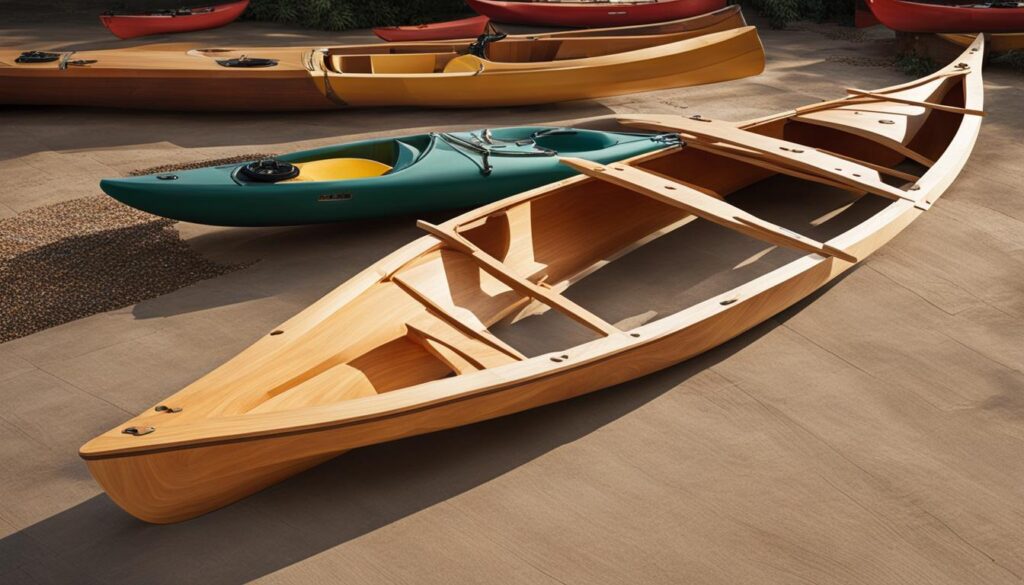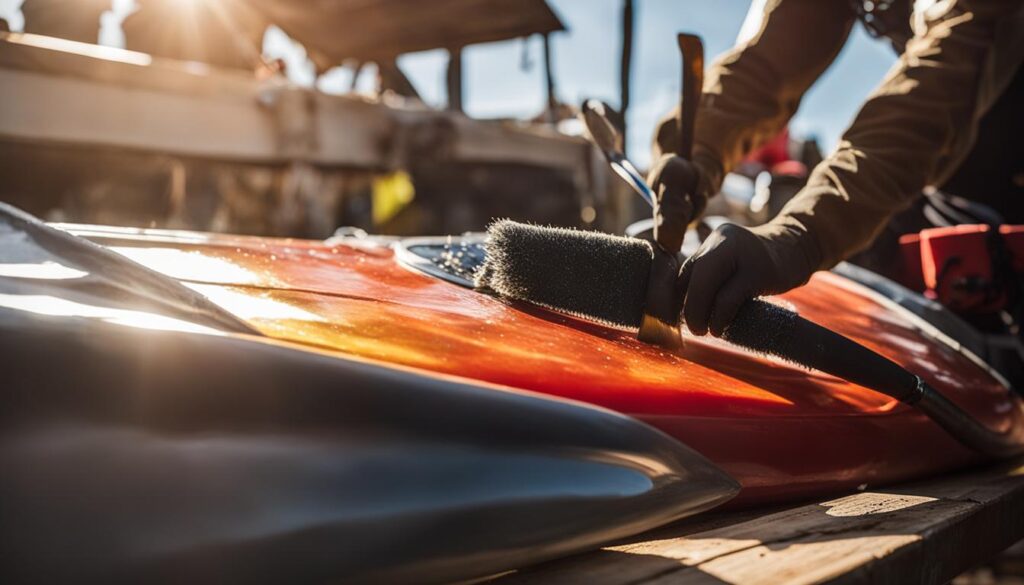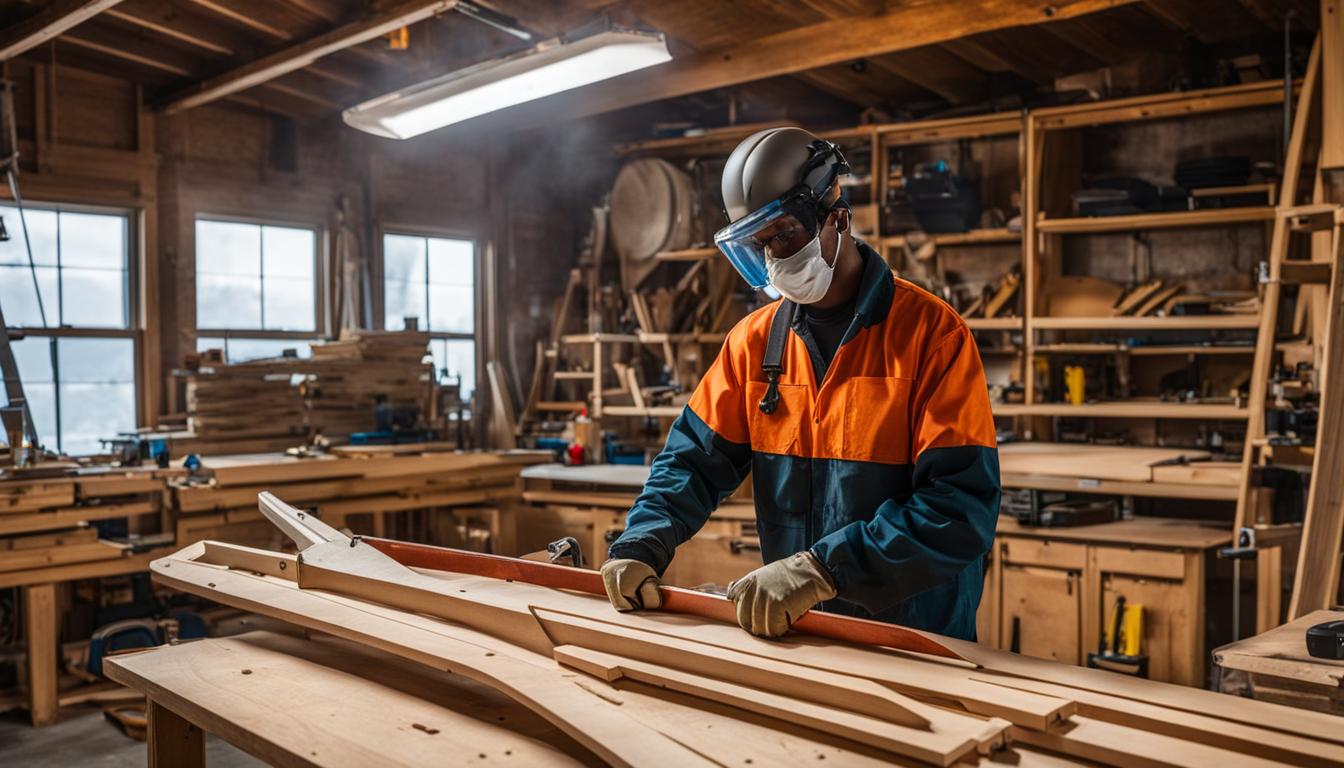Building your own kayak from scratch is an exciting and fulfilling project that allows you to create a personalized watercraft that suits your needs and preferences. Whether you’re a beginner or an experienced woodworker, this comprehensive guide will provide you with step-by-step instructions and valuable tips for successfully building your own kayak.
With the right materials and homemade kayak building techniques, you can embark on a rewarding journey of constructing your very own kayak. From choosing a design and building the frame to stripping the hull and fiberglassing, each stage of the process will help you create a well-built and functional kayak that you can proudly call your own.
Key Takeaways:
- Building your own kayak allows you to create a customized watercraft that suits your needs and preferences.
- Consider factors like the type of kayaking you plan to do and the desired stability and speed of your kayak when choosing a design.
- Building the frame is an essential step that provides support and structure to your kayak.
- Stripping the hull involves cutting and milling strips of wood, such as cedar, to create the outer shell of the kayak.
- Fiberglassing the hull adds strength and durability, while sanding and varnishing give the kayak a smooth finish and protect the wood.
Choosing a Design and Plans
When it comes to DIY kayak building, one of the first decisions you’ll need to make is choosing a design that suits your needs and preferences. Consider factors such as the type of kayaking you plan to do, whether it’s for recreational purposes or more adventurous expeditions. Additionally, think about the desired stability and speed of your kayak. This will help guide you in selecting the right design.
There are a wide variety of custom kayak design ideas available. Longer and narrower kayaks are generally faster but less stable, while shorter and wider kayaks offer more stability. You’ll need to strike a balance based on your personal preferences and intended use.
Once you’ve decided on a design, you can either purchase kayak construction plans from reputable sources or create your own using lofting techniques. Lofting involves creating templates of the forms and cross sections of the kayak’s hull at regular intervals. This ensures accurate construction and a well-built kayak that meets your requirements.
Table: Pros and Cons of Different Kayak Designs
| Kayak Design | Pros | Cons |
|---|---|---|
| Long and Narrow | Higher speed | Less stability |
| Short and Wide | Increased stability | Slower speed |
| Moderate Length and Width | Balance of speed and stability | May not excel in either aspect |
Consider your skill level and the amount of time you can invest in your project. If you’re a beginner, it may be helpful to start with basic kayak building instructions and plans that are specifically designed for newcomers to the craft.
“Choosing the right kayak design is crucial for ensuring a satisfying paddling experience. Take the time to consider how you will be using your kayak and what features are most important to you. This will help guide you in selecting the design that best suits your needs.” – John Smith, DIY Kayak Enthusiast
By carefully selecting the right design and plans for your DIY kayak project, you’ll be off to a great start in creating a watercraft that is both functional and tailored to your preferences.
Building the Frame
Now that you have chosen a design for your kayak, it’s time to start building the frame. This is an important step that will provide the structure and support for your kayak. Before you begin, make sure you have all the necessary materials on hand. Here is a list of the basic kayak DIY materials you will need:
- Plywood for the platform
- Sawhorses
- Templates or plans for the forms
- Tape
- Screws
To start, create a platform using plywood and sawhorses. This will serve as your work surface for constructing the frame. Make sure the platform is long enough to accommodate the length of your kayak. Once the platform is ready, you can cut out the forms of the kayak using templates or plans. These forms will serve as the backbone of your kayak, providing support and structure.
When cutting out the forms, be sure to cover the edges with tape to prevent them from sticking during the gluing process. Secure the forms to the platform using screws and adjust them to ensure proper alignment and a smooth hull. Pay close attention to the instructions provided in your chosen design or plans to ensure accuracy.
Table: List of Basic Kayak DIY Materials
| Material | Quantity |
|---|---|
| Plywood | 1 sheet |
| Sawhorses | 2 |
| Templates or plans | As required |
| Tape | 1 roll |
| Screws | As required |
By following these steps and using the right materials, you can start building the frame of your kayak. This part of the process is crucial for creating a sturdy and well-constructed kayak. Once the frame is complete, you can proceed to the next step of stripping the hull.

Stripping the Hull
Once the frame is set up, it’s time to start stripping the hull of your kayak. This step involves cutting and milling strips of wood, typically cedar, to cover the hull of the kayak. The process of stripping the hull is not only functional but also adds a visually appealing aesthetic to your kayak.
Measure the circumference of the widest form on your kayak frame and calculate the number of strips needed to cover the hull. Using a table saw with feather boards, ensure the strips have a uniform thickness. Mill the edges of the strips using a router table with a bead and cove bit, creating a tongue and groove joint that will allow the strips to fit together smoothly.
Tip: When choosing cedar for your kayak strips, look for high-quality, straight-grain cedar to ensure the best results. This type of wood is lightweight, water-resistant, and easy to work with.
Once the strips are prepared, you can start attaching them to the forms of the kayak frame. Begin at the strong back and work towards the center of the hull. Use a combination of glue and staples to secure the strips in place. To ensure the strips hold together properly, use masking tape to hold them together where they may pull apart during the gluing process. Continuously check the alignment as you progress to maintain a smooth and symmetrical hull.
After the hull is fully stripped, trim the strips flush with the stems using a sharp knife or chisel. This will give your kayak a clean and finished look. Smooth out any joints using a plane and sandpaper, ensuring a seamless transition between strips. Take your time and pay attention to detail during this step, as it will significantly impact the overall appearance and functionality of your kayak.
Table: Required Materials for Stripping the Hull
| Materials | Description |
|---|---|
| Cedar wood | High-quality, straight-grain cedar for the kayak strips |
| Table saw | Used to cut the cedar strips to the desired width |
| Router table | Equipped with a bead and cove bit for milling the edges of the strips |
| Glue | Strong adhesive to secure the strips to the forms |
| Staples | Used in conjunction with glue to reinforce strip attachment |
| Masking tape | Keeps the strips together during the gluing process |
| Sharp knife or chisel | For trimming the strips flush with the stems |
| Plane and sandpaper | Tools for smoothing out joints and creating a seamless hull surface |
Fiberglassing and Finishing
Once you have completed stripping the hull of your kayak, the next crucial step is fiberglassing and finishing. This process adds strength, durability, and a protective layer to your kayak’s exterior and interior. Fiberglassing involves applying layers of fiberglass cloth and epoxy resin to reinforce the hull, while finishing includes sanding and varnishing to give your kayak a smooth and attractive appearance.
To begin fiberglassing, lay a layer of fiberglass cloth over the stripped hull. Ensure that the cloth covers the entire surface, including the exterior and interior of the kayak. Use an epoxy resin to saturate the cloth, applying multiple coats for added strength. Allow each coat to dry before applying the next one. Sand the hull between coats to achieve a fair and smooth surface.
After fiberglassing, it’s time to give your kayak a beautiful finish. Start by sanding the entire surface of the kayak to remove any imperfections and create a smooth hull. Begin with a coarse-grit sandpaper and gradually move to finer grits for a polished finish. Once sanded, wipe away any dust and debris. Then, apply a coat of varnish to protect the wood and enhance its natural beauty. Choose a marine-grade varnish suitable for exterior use.
Repeat the sanding and varnishing process as needed to achieve the desired finish. Each coat of varnish should be allowed to dry completely before applying the next one. Sand lightly between coats to ensure a smooth and glossy appearance. Once you are satisfied with the finish, your kayak is ready for the water!

Fiberglassing and Finishing Tips:
- Wear protective gear such as gloves, safety glasses, and a mask when working with epoxy resin and varnish.
- Follow the manufacturer’s instructions for mixing and applying the epoxy resin.
- Ensure proper ventilation in your workspace when working with epoxy resin or varnish fumes.
- Use a foam roller or brush to apply epoxy resin and varnish evenly.
- Consider applying multiple coats of varnish for added protection and a glossy finish.
Conclusion
Building your own kayak can be a rewarding and enjoyable experience. With the DIY kayak construction tips and techniques outlined in this guide, you can confidently embark on your kayak building journey. From choosing a design and building the frame to stripping the hull and fiberglassing, each step is important in creating a well-built and functional kayak.
Remember to follow the basic kayak building instructions and take your time throughout the process. It’s important to prioritize safety and ensure that you have the right materials and tools for the job. By doing so, you can create a customized kayak that suits your needs and preferences.
Whether you are a beginner or have experience in woodworking, DIY kayak building allows you to unleash your creativity and craft a watercraft that is unique to you. So, gather your supplies, get started, and enjoy the satisfaction of paddling in a kayak that you built with your own hands!
FAQ
Can I build a kayak even if I’m a beginner?
Absolutely! This comprehensive guide provides step-by-step instructions that are suitable for both beginners and experienced woodworkers.
How do I choose a design for my kayak?
Consider factors such as the type of kayaking you plan to do and the desired stability and speed of your kayak. Longer, narrower kayaks are faster but less stable, while shorter, wider kayaks offer more stability.
Where can I get the plans for building a kayak?
You can purchase plans from reputable sources or create your own using lofting techniques. Lofting involves creating templates of the forms and cross sections of the kayak’s hull at regular intervals.
What materials do I need to build the frame of the kayak?
You can build a simple platform using plywood and sawhorses to serve as the frame for your kayak.
How do I strip the hull of my kayak?
Stripping the hull involves cutting and milling strips of wood from materials such as cedar. These strips are then attached to the forms using glue and staples, starting from the strong back and working towards the center of the hull.
What is the purpose of fiberglassing the kayak?
Fiberglassing adds strength and durability to the hull of the kayak. It involves applying fiberglass cloth and epoxy resin in multiple coats, sanding between each coat for a smooth finish.
How do I finish the kayak after fiberglassing?
After fiberglassing, you can sand the entire surface to achieve a fair and smooth hull. Then, apply a coat of varnish to protect the wood and enhance its appearance. Repeat the sanding and varnishing process as needed.
Is building my own kayak enjoyable?
Building your own kayak can be a fulfilling and enjoyable experience. By following the steps outlined in this guide, you can create a customized kayak and embark on countless adventures on the water.





